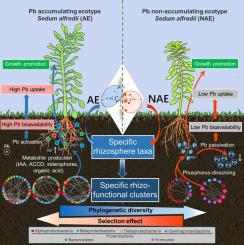Environment International ( IF 11.8 ) Pub Date : 2020-07-07 , DOI: 10.1016/j.envint.2020.105912 Runze Wang 1 , Dandi Hou 2 , Jiuzhou Chen 1 , Jiahao Li 1 , Yingyi Fu 1 , Sen Wang 3 , Wei Zheng 3 , Lingli Lu 1 , Shengke Tian 1

|
Lead (Pb) contamination presents a widespread environmental plague. Sedum alfredii is widely used for soil phytoremediation owing to its capacity to extract heavy metals, such as Pb. Although efficient Pb extraction is mediated by complex interactions between the roots and rhizospheric bacteria, the mechanism by which S. alfredii recruits microorganisms under Pb stress remains unclear. The Pb-accumulating ecotype (AE) and non-accumulating ecotype (NAE) of S. alfredii recruited different rhizobacterial communities. Under Pb stress, AE rhizosphere-enriched bacteria assembled into stable-connected clusters with higher phylogenetic and functional diversity. These microbes, e.g., Flavobacterium, could release indoleacetic acid to promote plant growth and siderophores, thereby increasing Pb availability. The NAE rhizosphere-enriched functional bacteria “desperately” assembled into highly specialized functional clusters with extremely low phylogenetic diversity. These bacteria, e.g., Pseudomonas, could enhance phosphorus solubilization and Pb precipitation, thereby reducing Pb stress and plant Pb accumulation. High niche overlap level of the rhizo-enriched species raised challenges in soil resource utilization, whereas the NAE community assembly was markedly constrained by environmental “selection effect” than that of AE rhizobacterial community. These results indicate that different ecotypes of S. alfredii recruit distinct bacterial functional assemblies to drive specific plant-soil feedbacks for different survival in Pb-contaminated soils. To cope with heavy metal stress, NAE formed a highly functional and specialized but vulnerable community and efficiently blocked heavy metal absorption by plants. However, the AE community adopted a more stable and elegant strategy to promote plant growth and the accumulation of dry matter via multiple evolutionary strategies that ensured a high yield of heavy metal phytoextraction. This for the first time provides new insights into the roles of rhizosphere microbes in plant adaptations to abiotic stresses.
中文翻译:

独特的根瘤菌功能性装配可帮助两种东南景天生态型在铅胁迫下采取不同的生存策略。
铅(Pb)污染造成了广泛的环境灾难。景天景天由于其提取重金属(如Pb)的能力而被广泛用于土壤植物修复。尽管有效的Pb提取是由根与根际细菌之间复杂的相互作用介导的,但S. alfredii在Pb胁迫下募集微生物的机制仍不清楚。S. alfredii的Pb累积生态型(AE)和非累积生态型(NAE)募集了不同的根瘤菌群落。在铅胁迫下,富含AE根际的细菌组装成稳定连接的簇,具有更高的系统发育和功能多样性。这些微生物,例如黄杆菌可以释放吲哚乙酸以促进植物的生长和铁载体,从而增加铅的利用率。富含NAE根际的功能细菌“拼命”组装成高度专业化的功能簇,系统发育多样性极低。这些细菌,例如假单胞菌,可以增强磷的溶解度和Pb的沉淀,从而减少Pb胁迫和植物Pb的积累。富集根瘤菌的物种的高生态位重叠水平对土壤资源利用提出了挑战,而与AE根瘤菌群落相比,NAE群落的组装受到环境“选择效应”的明显限制。这些结果表明不同的生态型S. alfredii募集不同的细菌功能组件,以驱动特定的植物-土壤反馈,以在被Pb污染的土壤中实现不同的存活率。为了应对重金属胁迫,NAE形成了一个功能强大,专业化但易受伤害的社区,并有效地阻止了植物吸收重金属。但是,AE社区采取了更加稳定和优雅的策略,通过多种进化策略来促进植物生长和干物质积累,从而确保了重金属植物提取的高产。这首次为根际微生物在植物适应非生物胁迫中的作用提供了新的见解。


























 京公网安备 11010802027423号
京公网安备 11010802027423号